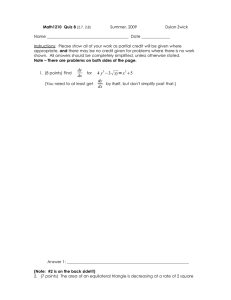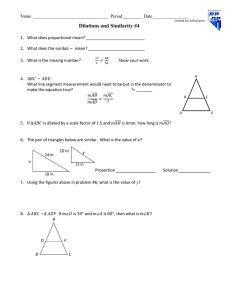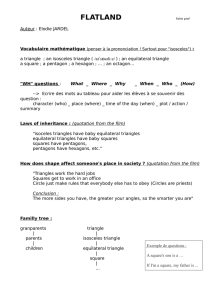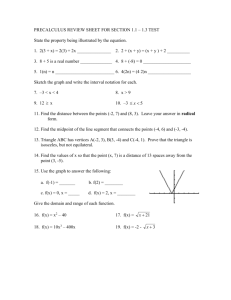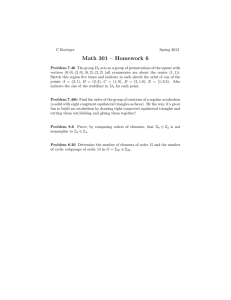equilateral triangles whose vertices belong to three given straight lines
advertisement
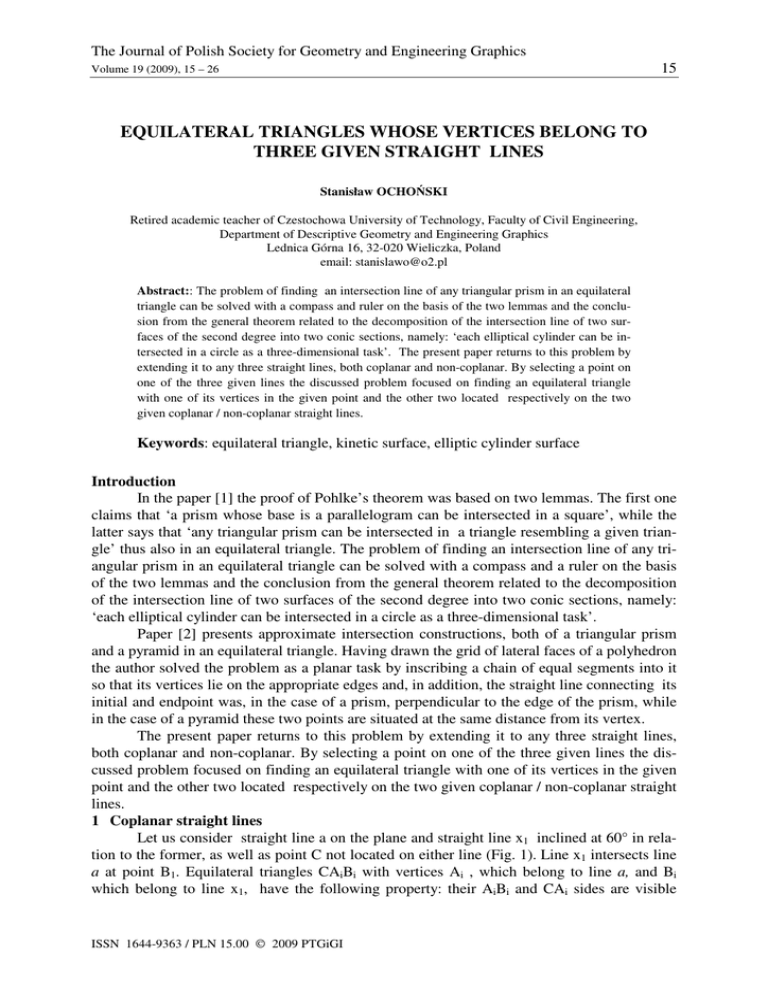
The Journal of Polish Society for Geometry and Engineering Graphics 15 Volume 19 (2009), 15 – 26 EQUILATERAL TRIANGLES WHOSE VERTICES BELONG TO THREE GIVEN STRAIGHT LINES Stanisław OCHOŃSKI Retired academic teacher of Czestochowa University of Technology, Faculty of Civil Engineering, Department of Descriptive Geometry and Engineering Graphics Lednica Górna 16, 32-020 Wieliczka, Poland email: stanislawo@o2.pl Abstract:: The problem of finding an intersection line of any triangular prism in an equilateral triangle can be solved with a compass and ruler on the basis of the two lemmas and the conclusion from the general theorem related to the decomposition of the intersection line of two surfaces of the second degree into two conic sections, namely: ‘each elliptical cylinder can be intersected in a circle as a three-dimensional task’. The present paper returns to this problem by extending it to any three straight lines, both coplanar and non-coplanar. By selecting a point on one of the three given lines the discussed problem focused on finding an equilateral triangle with one of its vertices in the given point and the other two located respectively on the two given coplanar / non-coplanar straight lines. Keywords: equilateral triangle, kinetic surface, elliptic cylinder surface Introduction In the paper [1] the proof of Pohlke’s theorem was based on two lemmas. The first one claims that ‘a prism whose base is a parallelogram can be intersected in a square’, while the latter says that ‘any triangular prism can be intersected in a triangle resembling a given triangle’ thus also in an equilateral triangle. The problem of finding an intersection line of any triangular prism in an equilateral triangle can be solved with a compass and a ruler on the basis of the two lemmas and the conclusion from the general theorem related to the decomposition of the intersection line of two surfaces of the second degree into two conic sections, namely: ‘each elliptical cylinder can be intersected in a circle as a three-dimensional task’. Paper [2] presents approximate intersection constructions, both of a triangular prism and a pyramid in an equilateral triangle. Having drawn the grid of lateral faces of a polyhedron the author solved the problem as a planar task by inscribing a chain of equal segments into it so that its vertices lie on the appropriate edges and, in addition, the straight line connecting its initial and endpoint was, in the case of a prism, perpendicular to the edge of the prism, while in the case of a pyramid these two points are situated at the same distance from its vertex. The present paper returns to this problem by extending it to any three straight lines, both coplanar and non-coplanar. By selecting a point on one of the three given lines the discussed problem focused on finding an equilateral triangle with one of its vertices in the given point and the other two located respectively on the two given coplanar / non-coplanar straight lines. 1 Coplanar straight lines Let us consider straight line a on the plane and straight line x1 inclined at 60° in relation to the former, as well as point C not located on either line (Fig. 1). Line x1 intersects line a at point B1. Equilateral triangles CAiBi with vertices Ai , which belong to line a, and Bi which belong to line x1, have the following property: their AiBi and CAi sides are visible ISSN 1644-9363 / PLN 15.00 2009 PTGiGI 16 S. Ochoński: The Equilateral Triangles whose Vertices Belong to Three Non Coplanar Straight Lines from point B1 at 60° while their third sides CBi at 120°. On the basis of a theorem from elementary geometry, circles ki circumscribed on these triangles contain point B1. The line n, which contains point C, and is perpendicular to line a is the axis of rectangular symmetry of the discussed configuration, thus there is the other straight line x2 inclined to line a at 60° as well as equilateral triangles CAsiBsi, symmetrical to triangles CAiBi with respect to this line. Cs – the point of intersection of the straight lines xi (i= 1,2) is a symmetrical point to point C with regard to line a. Fig. 1 Fig. 2 Let us also notice that in triangles CA1 Ai and CB1Bi, CA1 = CB1, CAi = CBi and the angles CA1Ai = CB1Bi = 120°, they are congruent, hence their third sides are equal. If A1Ai = B1Bi (i= 2,3,…), then A1A2 = B1B2, A1A3= B1B3 etc. and then A2A3 = B2B3 etc. The obtained two projective and congruent chains of points on lines a (Ai) and x1(Bi) generate a parabola with its focus F=C, axis o1 = CB1 and vertex P1. The straight lines si = AiBi along with the bases of these chains of points are their tangents. Similarly, the projective and congruent chains of points a(Asi) and x2 (Bsi) generate the second parabola, symmetrical to the first with respect to line n, with the same focus, axis o2=CA1 and vertex P2. Using the above remarks, whose visible illustration is Fig.1, one can propose a few different solutions to construct an equilateral triangle with one vertex in a given point and the other two which belong to the two given lines respectively. 1.1 The first solution We shall construct an equilateral triangle for the two given straight lines a and b as well as point C located in the plane of those two lines with one vertex of the triangle in point C and the other two A and B located respectively on the given straight lines a and b. Let us draw line n through point C, perpendicular to, for example, line a and let us select on it point Cs symmetrical to point C with respect to line a. Then, let us draw lines xi(i=1,2) through point C, inclined at 60° with regard to the line a. Intersection points Bi(i=1,2) of the given line b with previously set lines xi(i=1,2) are the other vertices of the equilateral triangles we seek while the sections CBi(i=1,2) are their sides. The circles with their centres at point C and radii CBi(i=1,2) intersect the straight line a at points Ai(i=1,2,3,4), of which only two Ai(i=1,2) along with points C and Bi(i=1,2) create two different equilateral triangles that meet the conditions of the task (Fig. 2). The Journal of Polish Society for Geometry and Engineering Graphics 17 Volume 19 (2009), 15 – 26 1.2 The second solution In this solution we use two auxiliary equilateral triangles C12 and C34 whose vertices 1 and 3 were assumed on the given straight line a (to the right of line n). Straight line x1, which connects points 2 triangle, whose side is the section CB1. The circle with the centre C and radius CB1 intersects line a at points Ai(i=1,2). If side CB1 is not perpendicular to line a, then only one of those points A1 with points C and B1 creates an equilateral triangle CA1B1. The second solution is obtained by assuming on line a points 1 and 3 on the left of line n (Fig. 3). Fig. 3 1.3 Fig. 4 The third solution Instead of two auxiliary triangles let us draw only one C12 with its vertex 1 situated on the given line a. Circle k circumscribed on this equilateral triangle intersects line a at points 1 and K. The straight line x1, which connects point K with point 2, intersects the given straight line b at point B1 – the other vertex of the equilateral triangle for which the section CB1 is its side. The circle with its centre at point C and radius CB1 intersects the straight line at points Ai(i=1,2). If side CB1 is not perpendicular to line a, only one of those points can be the vertex of the sought equilateral triangle CA1B1 (Fig. 4). 1.4 The fourth solution The radii pi(i=1,2) passing through the given point C inclined to one of two given lines e.g. line b, at 60 ° intersect it at points Oi(i=1,2). The radii oi(i=1,2) reflected of line b (the angle of incidence equals the angle of reflection), intersect line a at points Ai(i=1,2) – the other vertices of the sought equilateral triangles (Fig. 5). The circles with centers at point c and the radii CAi(i=1,2) intersect line b at points Bi(i=1,2). Only two of them Bi(i=1,2) along with points C and Ai(i=1,2) are the vertices of equilateral triangles which meet the conditions of the task (Fig.5). ISSN 1644-9363 / PLN 15.00 2009 PTGiGI 18 S. Ochoński: The Equilateral Triangles whose Vertices Belong to Three Non Coplanar Straight Lines Fig. 5 1.5 Fig. 5a The fifth solution The algorithm of the final solution is as follows. A given point C is assumed as the centre of co-central circles ki with a changeable radius Ri. These circles intersect the given lines a and b at points Xi, Vi and Yi as well as Ui. These four points in pairs which are not located on the lines a and b determine four straight lines jti(i=1,2,…,n; j=1,2,3,4). Let us consider one of them, for example 1ti, determined by the pair of points XiYi. Let us find the centre 1 Si of the segment XiYi and then let us find on this line such points 1Ai and 1Bi that the segments 1Si1Ai=1Si1Bi=½Ri (Fig. 5a). The dotted curved lines, which are sets of points 1Ai and 1 Bi, intersect lines a and b at the sought points Ai and Bi(i=1,2) – the vertices of equilateral triangles AiBiCi(i=1,2). It can be indicated that with such assumptions (straight line c is parallel to lines a and b) the dotted curved lines in Fig. 5a are the arcs of the same hyperbola but they belong to their different arms. Besides, points Ai and Bi(i=1,2) can be obtained as intersection points of lines a and b by circle k with its centre at point C and radius that equals the distance between them (that is one of the trivial cases). This solution has a different origin and differs from the previous four solutions in a significant way. All the cases described above can be applied for any three straight lines: parallel, containing a common point or those making up an open/close triside. 1.6 Trivial cases Trivial cases of the discussed problem certainly include: three parallel straight lines, one of which is at the same distance to the other two (Fig. 5a), three straight lines with one common point where one of the lines is a bisectrix of one of the two angles made up by the other two lines and, thirdly, three straight lines, two of which unite and the third intersects them or is parallel to them. Finding the vertices of the equilateral triangle which belong to given straight lines involves, in such cases, drawing simple constructions discussed in the course of elementary geometry. 1.7 Equilateral triangle with a given side length 1.7.1 Parallel lines The very mutual location of three parallel straight lines indicates that the length of the sides of equilateral triangles with vertices which belong to it is clearly defined and is a constant value. All equilateral triangles which meet the conditions of the task are either congruent or reversely congruent. 1.7.2 Straight lines with a common point In the case of three straight lines which have one common point equilateral triangles have a changeable side length in vertices belonging to those lines, thus it can be preset. Taking The Journal of Polish Society for Geometry and Engineering Graphics 19 Volume 19 (2009), 15 – 26 advantage of the central similarity let us construct an equilateral triangle with a given length of its side d and vertices A, B and C located on the given straight lines a, b and c which contain the common point W (Fig.6). In order to achieve that using one of the discussed solutions (1 – 5) let us draw an equilateral triangle 123 at point 1 with vertices belonging to the given straight lines a, b and c, respectively. Then, on the half-line being the extension of one of the sides of the triangle e.g. on the half-line e=13 we draw segment d of a given length from point 3 and as a result we obtain point A’(3A’=d) on it. Line f which passes through point A’ and which is parallel to line c intersects line a at point A which is homological to point 1 in this similarity with the centre W. Point W and a pair of transformed points 1 and A define this similarity, thus the other two vertices B and C, equivalent to points 2 and 3 were determined using parallelism of the particular straight lines preserved in the similarity. Figure 6 is a clear illustration of this construction. Fig. 6 1.7.3 Straight lines which make up a triside The construction of the vertices of the equilateral triangle ABC with the preset length of side d, inscribed in any given triside abc involves selecting of the three pairs of straight lines of the triside, e.g. pair ab, establishing the set of points Ci in the plane of these straight lines, which, along with the points Ai and Bi belonging to lines a and b, make equilateral triangles with the length of side d and then finding common points of this set with the third straight line c. ISSN 1644-9363 / PLN 15.00 2009 PTGiGI 20 S. Ochoński: The Equilateral Triangles whose Vertices Belong to Three Non Coplanar Straight Lines Fig. 7 As far as establishing this set goes the following statement is true: if two vertices of an equilateral triangle move along two intersecting straight lines then the third vertex describes two co-central ellipses with their foci at the intersection point of these lines and their axes contained in the bisectrixes of angles they generate (the proof of this statement is discussed in another paper). Since the third straight line in the discussed triside can generally intersect these ellipses at four points it indicates the number of solutions. Fig. 7a Fig. 7 shows the construction of the two axes of the ellipsis 1e for the lines a and b which contain the angle of 60° (with these assumptions the other ellipsis is degenerated to a segment). In order to find the vertices M and P of the ellipsis 1e, let us draw the lines ti (i=1,2) parallel to the previously drawn bisectrixes si(i=1,2) of the angles generated by the lines a and b at the distance of d/2 of the given side of an equilateral triangle. Lines ti(i=1,2) intersect lines a and b at points 1 and 4 respectively, and lines ni(i=1,2), in turn, which pass through them, perpendicular to lines si(i=1,2), intersect the lines b and a at points 2 and 3 respectively. The Journal of Polish Society for Geometry and Engineering Graphics Volume 19 (2009), 15 – 26 21 Let us build, on segments 12 and 34 (12=34=d), equilateral triangles whose third vertices M and P are the vertices of an ellipsis (because of the rectangular symmetry they are located on lines si). Point M is the vertex of the major axis while point P - is the vertex of the minor axis of this ellipsis. The second vertices N and Q of the axis of ellipsis are the symmetrical points to points M and P respectively with regard to the centre O (Fig. 7). The intersection points Ci(i=1,2) of the ellipsis determined by the axes MN and PQ with the third straight line c of the given triside abc can be found without drawing it by applying orthogonal axial affinity, e.g. with the axis s1. Since line c does not intersect the segment VW contained in the bisectrix s2, being the other degenerated ellipsis, the triangles AiBiCi(i=1,2) are equilateral triangles, with their sides equal to the preset segment d, inscribed in the given triside abc. From simple trigonometric formulas for given angles α and (180° - α) made by lines a and b as well as given segment d, the length of the major axis is MN= d(c tg ½ α + 3 ) while the length of the minor axis is PQ= d( 3 - tg ½ α). In the case of tangency of the ellipsis with line c (C1 = C2) we obtain only one solution and then the length of the side of such an equilateral triangle is the minimum length (dmin). dmin corresponds with any triside e.g. for the triside abc making up the equilateral triangle ABC with its side length d, dmin=½ d. Fig. 7 shows, on the left of the axis PQ, the construction dmin for triside abcs, symmetrical to a given triside abc with regard to axis s2. The pencil of ellipses jei(i=1,2,…, n; j=1,2) with the common centre O=a,b) and the axes contained in the lines si(i=1,2), drawn for different values of di(i=1,2,…,n), determines on the line cs the hyperbolic involution of two chain of points having the same base, determined by the two pairs of points EE’ and FF’. Point C=CC’ is one of the double points of this involution and at the same time the vertex of an equilateral triangle whose other two vertices A and B were determined on the lines a and b with one the five solutions described in section 1 (from 1.1 to 1.5). The length of the side of thus constructed equilateral triangle ABC is the sought value dmin for the triside abcs and as such for the triside abc (Fig. 7). Fig. 7a shows a construction of axes of two ellipses je(j=1,2) for straight lines a and b which generate an angle different from the angle of 60° while the third straight line c was assumed in such a way that it intersects these ellipses in four actual points Ci(i=1,2,3,4). These points are the vertices of four equilateral triangles AiBiCi whose vertices Ai and Bi belong to lines a and b respectively. Thus, if d≥dmin, then we can obtain one, two, three or four actual solutions. This construction can be also applied in the case of three straight lines having a common point, abandoning the solution presented in 1.7.2. 2 Non-coplanar straight lines As in the case of three coplanar straight lines, the task of finding an equilateral triangle with vertices belonging to three non-coplanar straight lines can be replaced by the task of constructing an equilateral triangle with one vertex in a given point (selected at random on one of the lines) and the other two belonging to two given coplanar/ non-coplanar straight lines respectively. Obviously, it must be assumed that the point does not lie in the plane of the lines while in the case of skew lines it does not lie on any of those lines. Of all possible correlated locations of the three straight lines in space, after selecting a given point on one of the lines we should consider three cases: a) two parallel lines and a point not situated in the plane of those lines, b) two intersecting lines and a point not contained in the plane determined by these lines and c) two skew lines and a point not situated on any of the lines. In order to find an equilateral triangle with one vertex in a given point and the ISSN 1644-9363 / PLN 15.00 2009 PTGiGI 22 S. Ochoński: The Equilateral Triangles whose Vertices Belong to Three Non Coplanar Straight Lines other two belonging to two given lines respectively (coplanar or not) we should follow the proposed algorithm which is a generalization for 3D space of the algorithm discussed in 1.5. The algorithm is as follows: - point C is assumed as the centre of auxiliary spheres Oi with changeable radius Ri ; - points XiVi and YiUi , at which lines a and b are intersected by spheres Oi , are determined; - by putting these points in pairs we obtain four straight lines jti (i=1,2,…, n; j=1,2,3,4); - we select one out of the four straight lines e.g. ti =XiYi ; - we determine the centre 1Si of segment XiYi ; - we find points 1Ai and 1Bi on the line 1ti so that they are as follows 1 1 Si Ai=1Si1Bi=1/2Ri (Ri is the radius of sphere Oi ) - by changing the radius of sphere Oi and repeating this action several times we obtain sets of points 1Ai and 1Bi which are continuous arcs of certain curves; - common points of A and B of these sets (arcs ) as well as straight lines a and b are the vertices of equilateral triangle ABC because CA=CB=R (R is the radius of sphere O where points A and B are situated) and SA =SB=1/2R thus AB=R which means that CA=CB=AB. Establishing one of the two sets of points makes it possible to solve the task since a side of the triangle CA/CB is determined. 2.1 Parallel lines Fig. 8 Let us assume that the given parallel lines lie in the plane of drawing τ, identified with the projection plane π (τ=π) and a given point C is located outside the line by the length of segment d (d=CCn) where Cn is the orthogonal projection of point C onto projection plane π. According to the above algorithm, we assume given point C as the centre of auxiliary spheres Oi with changeable radius Ri. If Ri>d then the projection plane intersects sphere Oi in circle ki with its centre at point Cn and radius ri. We calculate ri from the relation ri= R i2 - d 2 or we construct the leg of a right-angled triangle knowing d and Ri (Fig. 8). Circle ki (Cn, ri) intersects lines a and b at points XiVi and YiUi – they are points at which sphere Oi intersects these The Journal of Polish Society for Geometry and Engineering Graphics Volume 19 (2009), 15 – 26 23 lines. We find the centre 1Si of segment XiYi on line 1ti, then , on the line we draw such points 1 Ai and 1Bi that 1Si1Ai=1Si1Bi=½ Ri. By changing the radius of sphere Oi and repeating this action many times we obtain sets of points 1Ai and 1Bi on the projection plane, in the form of dotted curved arcs (one of them is enough for the solution). Points A1 and B1 – intersection points of lines a and b by these curves, are the vertices of the sought equilateral triangle A1B1C, whose orthogonal projection is isosceles triangle A1B1Cn. Points Vi and Ui are symmetrical to Xi and Yi with regard to line s containing point Cn and perpendicular to a//b, thus line 2ti determined by these points is symmetrical to line 1ti. This means that points A2 and B2 symmetrical to A1 and B1 (with regard to the same line s) are the vertices of the other equilateral triangle A2B2C which meets the conditions of the task. Lines 3ti and 4ti mutually symmetrical with regard to line s do not offer additional solutions. The revolved section of one of the triangles AiBiC(i=1,2) is the test of accuracy of the construction. By choosing line c parallel to lines a//b out of lines ci(i=1,2,…,n) we obtain a triangular prism with two equilateral triangles with their vertices located on their edges. The parallel planes to the planes of those triangles intersect this prism in the congruent and reversely congruent triangles. This method of determining the intersection of a triangular prism significantly differs from the solution discussed in the paper [2]. 2.2 Intersecting straight lines Assuming intersecting lines a and b in the plane τ = π, and point C situated at d>0 off the line, the construction of finding an equilateral triangle with one of its vertices in a given point C and two others located on the given lines a and b respectively will resemble that of parallel lines (2.1 and Fig. 8). By distinguishing the line passing through point W=a·b out of the lines ci(i=1,2,...,n) containing point C, we obtain a triangular pyramid with equilateral triangles with vertices belonging to its edges. By using the similarity of solids in space it is possible to find the section of such a pyramid in an equilateral triangle with a preset side. 2.3 Skew lines Now let us assume two skew lines a and b and point C not located on either of the lines and let us assume that point C is located in the plane identified with the projection plane, line b is perpendicular to this plane while line a is skew with regard to line b and along with the projection plane it generates angle α≠90°. By solving this task with one orthogonal projection, the location of line a is determined by: its orthogonal projection an, its trace Ha=a·π and its inclination angle to projection plane α≠90°. The assumption that point C is located on projection plane π is in this case synonymous with the fact that it is a point chosen at random on the third line c since the projection plane can still move in parallel (Fig. 9). ISSN 1644-9363 / PLN 15.00 2009 PTGiGI 24 S. Ochoński: The Equilateral Triangles whose Vertices Belong to Three Non Coplanar Straight Lines Fig. 9 By following the established algorithm we assume point C as the centre of sphere Oi with the changeable radius Ri. We determine intersection points Xi and Yi of lines a and b by sphere Oi (for the sake of clarity of the drawing in this construction we use only one of the four lines ti). Next we find the centre 1Si of the segment XiYi and then we mark points 1Ai and 1 Bi on line 1ti, which is the extension of this segment, so that 1Si1Ai = 1Si1Bi = ½ Ri. We use dots to mark orthogonal projections of these points (this is limited to points 1Ai only and their orthogonal projections 1Ani). By changing the radii of the sphere and repeating these constructions sufficient number of times we obtain a dotted arc of a curve which is the orthogonal projection of a curve being the set of points 1Ai (Fig. 9). The dotted arc of a curve intersects the orthogonal projection an of line a and at point An, which is the projection of point A belonging to line a and being the second vertex of the sought equilateral triangle for which segment AC is its side. Knowing the length of side AC of this triangle we find its third vertex on line b so that CA = CB. The test of accuracy of the realized construction can be a revolved section of segment AB. If its length AnBx = CAx = CBx then an equilateral triangle ABC can be built on one of these segments. In the set of these lines ci containing point C there exists line c, skew with regard both to line a and b. Thus the equilateral triangle ABC is a triangle whose vertices belong to the three lines a, b and c respectively in skew pairs. Problems of the so called ‘dotted curves’ used in the discussed constructions, establishing in 3D space a set of points being the third vertices of equilateral triangles with the constant side length where the other two vertices move along the two given straight lines (coplanar/ non-coplanar), or finding dmin for three straight lines skew in pairs (and not only) are open and will be subject to further research in this field. As far as the ‘dotted curves’ are concerned, it is a well-known fact that in the case of two coplanar straight lines these are arcs of curves of the second or fourth degree (yet there is no synthetic proof); while in the case of two skew lines it is clear that they are contained in a hyperboloid of one sheet or hyperbolic paraboloid. The Journal of Polish Society for Geometry and Engineering Graphics 25 Volume 19 (2009), 15 – 26 2.3.1 A special case Fig. 10 Let us now consider an interesting case of two skew and perpendicular straight lines a and b and point C which is not a point chosen at random on the third straight line c but a point where the plane containing one of the lines a/b and perpendicular to the other a/b intersects line c. By assuming on the plane τ = π a straight line a and point C not united with point bn being the orthogonal projection of line b we meet the condition that the plane containing line a and perpendicular to line b (there is only one) intersects line c at point C which is not chosen at random on this line (compare: the assumptions in 2.3. and Fig.9). In order to find an equilateral triangle with a vertex in a given point C and the other two belonging to the given lines a and b respectively, the following procedure was applied (Fig.10). Point bn , being the orthogonal projection of line b onto projection plane π, was assumed as the centre of circle k with radius r = bnC. This circle intersects the given line a at points Ai (i = 1,2). Spheres Oi (I = 1,2), with the centre C, containing points Ai(i= 1,2), intersect line b at points Bi (i=1,2,3,4) which, along with points C and Ai(i=1,2), make up four equilateral triangles. Their orthogonal projections are isosceles triangles. Let us consider one of those, e.g. A1B1C. Its two vertices A1 and C lie on circle k and the third vertex – point B1 is a point of sphere O1, thus CA1 = CB1. And since sides CB1 and A1B1 have their orthogonal projections of the same length and, in addition, they are inclined to the projection plane at the same angle then A1B1 = CB1. This means that the triangle A1B1C is an equilateral triangle which meets the conditions of the task. Considering the other three triangles in an analogical way indicates that each of the four triangles is an equilateral triangle. The revolved sections of these triangles are the test of accuracy of the realized construction. If one of those two spheres does not intersect line b, then there are only two solutions, as in the case when circle k is tangent to line a (the radius of this circle r=dmin). On the other hand, when point C as the point of intersecting line c by the plane is situated on line a then there are also only two solutions. When circle k does not intersect line a ( r < dmin) and it is not tangent to it, then there are no such equilateral triangles which have one vertex in a given point C and the other two located on lines a and b. ISSN 1644-9363 / PLN 15.00 2009 PTGiGI 26 S. Ochoński: The Equilateral Triangles whose Vertices Belong to Three Non Coplanar Straight Lines References: [1]. Otto E.: Geometria wykreślna. PWN, Warszawa 1954. [2]. Ochoński S., Służalec A.: Przybliżone konstrukcje przekroju trójściennego graniastosłupa i ostrosłupa w trójkącie równobocznym. Zeszyty Naukowe GEOMETRIA Nr 11, Poznań 1980. TRÓJKĄTY RÓWNOBOCZNE O WIERZCHOŁKACH NALEŻĄCYCH DO TRZECH DANYCH PROSTYCH W artykule [2] podano przybliżone konstrukcje przekroju zarówno trójściennego graniastosłupa, jak i ostrosłupa w trójkącie równobocznym. Po uprzednim sporządzeniu siatki pobocznicy wielościanu, problem rozwiązano jako zadanie płaskie, wpisując w nią łamaną o równych odcinkach tak, aby jej wierzchołki leżały na odpowiednich krawędziach. Ponadto, by prosta łącząca jej początek i koniec była w przypadku graniastosłupa prostopadła do jego krawędzi, zaś w przypadku ostrosłupa, by te dwa punkty znajdowały się w takiej samej odległości od jego wierzchołka. W niniejszej publikacji powrócono do tego problemu, rozszerzając go na każde trzy proste zarówno współpłaszczyznowe, jak i niewspółpłaszczyznowe. Obierając na jednej z trzech danych prostych dowolny punkt, rozważany problem sprowadzono do zadania znalezienia trójkąta równobocznego o jednym jego wierzchołku w danym punkcie oraz pozostałych leżących odpowiednio na dwóch danych prostych komplanarnych/niekomplanarnych.

